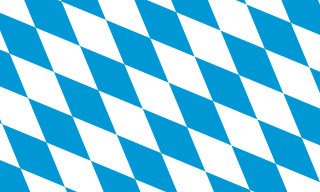
Bavaria, officially the Free State of Bavaria, is a state in the southeast of Germany. With an area of 70,550.19 km2 (27,239.58 sq mi), it is the largest German state by land area, comprising roughly a fifth of the total land area of Germany, and with over 13.08 million inhabitants, it is the second most populous German state, behind only North Rhine-Westphalia; however, due to its large land area, its population density is below the German average. Major cities include Munich, Nuremberg, and Augsburg.

Lower Bavaria is one of the seven administrative regions of Bavaria, Germany, located in the east of the state. It consists of nine districts and 258 municipalities.
Altötting is a Landkreis (district) in Bavaria, Germany. It is bounded by Austria and the Bavarian districts of Traunstein, Mühldorf and Rottal-Inn.

The Bavarian Alps is a collective name for several mountain ranges of the Northern Limestone Alps within the German state of Bavaria.

Bavarians are an ethnographic group of Germans of the Bavaria region, a state within Germany. The group's dialect or speech is known as the Bavarian language, native to Altbayern, roughly the territory of the Electorate of Bavaria in the 17th century.

Central or Middle Bavarian form a subgroup of Bavarian dialects in large parts of Austria and the German state of Bavaria along the Danube river, on the northern side of the Eastern Alps. They are spoken in the 'Old Bavarian' regions of Upper Bavaria, Lower Bavaria and in the adjacent parts of the Upper Palatinate region around Regensburg, in Upper and Lower Austria, in Vienna, in the state of Salzburg, as well as in the northern and eastern parts of Styria and Burgenland. Before 1945 and the expulsions of the Germans, it was also spoken in Hungary and southern Bohemia and Moravia. It also influenced Austrian German.

The Duchy of Bavaria was a frontier region in the southeastern part of the Merovingian kingdom from the sixth through the eighth century. It was settled by Bavarian tribes and ruled by dukes (duces) under Frankish overlordship. A new duchy was created from this area during the decline of the Carolingian Empire in the late ninth century. It became one of the stem duchies of the East Frankish realm, which evolved as the Kingdom of Germany and the Holy Roman Empire.

The Kingdom of Bavaria was a German state that succeeded the former Electorate of Bavaria in 1806 and continued to exist until 1918. With the unification of Germany into the German Empire in 1871, the kingdom became a federated state of the new empire and was second in size, power, and wealth only to the leading state, the Kingdom of Prussia.

Rottenburg an der Laaber is a town in the district of Landshut, in Bavaria, Germany. It is situated on the river Große Laber, 21 km northwest of Landshut.

Neufahrn i. NB or Neufahrn in Niederbayern is a municipality in the district of Landshut in Bavaria in Germany. Its Bavarian name is Neifing.

Große Laber is a river in Bavaria, Germany, a right tributary of the Danube.
Laber or Laaber is an element in Bavarian place names which goes back to the word Labera meaning "foaming water". The spellings Laber and Laaber are interchangeable in older texts, and are still not always consistently distinguished today. It may refer to:

The Schwarze Laber is a river in Bavaria, Germany, and a left tributary of the Danube. Its source is near Neumarkt in der Oberpfalz. It is approx. 78 km long. It flows southeast through the small towns Parsberg, Beratzhausen, Laaber and Deuerling. It flows into the Danube in Sinzing.

Bachmühlbach is a river of Bavaria, Germany. It flows into the Schwarze Laber in Deuerling.

Breitenbrunner Laber is a river in the Franconian Jura of Bavaria, Germany. It is formed at the confluence of the Wissinger Laber and the Bachhaupter Laber in Breitenbrunn. It flows into the Weiße Laber near Dietfurt.

The Kleine Laber is a river in Bavaria, Germany. The Kleine Laber issues into the Große Laber, which issues into the Danube River.

Weiße Laber is a river in Bavaria, Germany. It flows into the Altmühl in Dietfurt.

The Wissinger Laber is the right headwater of the Breitenbrunner Laber in the Franconian Jura in Bavaria, Germany.

The Bayerbacher Bach or Bayerbach is a stream in Bavaria, Germany. It is a tributary of the Kleine Laber in Lower Bavaria.

The Hartlaber is a stream in Bavaria, Germany. It is a distributary of the Große Laber in Lower Bavaria.



















